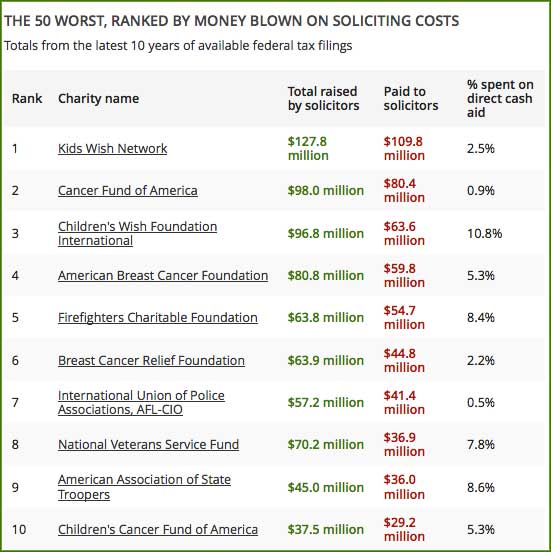The sensational story of a sham charity operator using a stolen identity and dodging an FBI warrant led to a 2010 Tampa Bay Times’ series. It also prompted a closer look at how much charities actually spend on people in need.
Reporters Kris Hundley at the Times and Kendall Taggart at the Center for Investigative Reporting (CIR) looked at payments non-profit charities made to for-profit fundraising companies as one indicator of how much money went to people in need. Using tax filings and public records for a 10-year period, Kris and Kendall found the 50 worst charities raised $1.35 billion and gave $1 billion of that to fundraisers.
For their work, Kris and Kendall are this year’s winners of the gold Barlett and Steele Award for Investigative Business Journalism.
“We followed the money to see where it got plugged up in the system. Most of it stopped at the fundraiser,” Kris says. “We were shocked when we added up the dollar figures.”
The findings helped create an interactive national database of the 50 worst charities and an ongoing “America’s Worst Charities” series. Reporters looked at 10 years of data to make stronger claims about the groups and their practices, Kendall says. In a sidebar about the methodology, the reporters say their data focuses on charities that paid fundraisers a large portion of donations in at least 75 percent of all campaigns over the years.
Looking back 10 years posed some challenges. Some news stories they needed weren’t available online so they had to find them the old-fashioned way: in the morgue. Kendall says they dug through news clippings in the basement of the Kansas City Star.
Kris and Kendall, who is based in California, worked in their separate offices when they weren’t travelling together to interview charity operators, donors and experts. Having a partner during the yearlong process was valuable, Kris says.
“When one of us got stuck in a rabbit hole we couldn’t get out of, we had somebody to call,” Kris says. “We did go down a lot of holes that yielded nothing and sometimes we hit oil.”
To manage all of the information, Kendall says they created a spreadsheet with their tentative findings such as cracks in the regulatory system on the top row. They entered information that supported those findings under those headings.
“That helped us track and synthesize what we were finding before we were able to sit down and write about it,” Kendall says.
Kris suggests establishing an organization strategy early. She also says to record dates of emails and calls to show a history of trying to reach people.
Kris says she did not expect the series to have such an impact. There have been regulatory changes, investigations and more scrutiny placed on charities, particularly the ones that made the Times’ list.
A greater impact has been providing a resource for regular people, Kendall says. For instance, an elderly man without Internet access heard her on an NPR segment about the series, she says. He later called and asked her to mail him the list of the 50 worst charities so he could avoid them. Kendall says he’d called the public library to get her phone number.
For more tips from Kris and Kendall, view their slideshow from an Investigative Reporters and Editors presentation.











